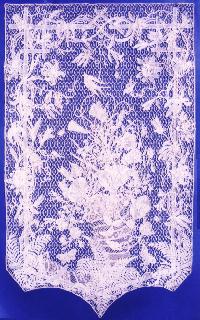This gallery is also named after a founder member of the museum, Eleanor Norman. It houses many exquisite examples of the world’s finest collection of Honiton Lace. Honiton lace is one of the world’s high quality laces which was much in demand during the 17th and 18th centuries amongst the rich both at home and abroad.
The main characteristic of Honiton lace is the ‘sprig’ a term used for a flower, leaf or other design – each made separately. The finished sprigs were then sewn onto net to form the finished design or garment. The designs for sprigs are usually taken from the Devon countryside.

There never was a lace factory in Honiton – it was a cottage industry. Lace ‘manufacturers’ employed people all around the area to design the lace and to make it and then they sold the finished product. Lace makers worked at home and were poorly paid. Often manufacturers owned the local shops and paid their workers with tokens which could only be spent in their own shop.
Before machines were invented, all net was made by hand. Charlotte Treadwin wrote “This kind of net was very expensive, and one of the old people formerly in the trade showed me a piece about eighteen inches square, which she had made just previous to the machine netts coming into use, and which cost her in making fifteen pounds, although it was plain nett only. From the great difference of price, as the same size piece of lace at the very commencement of its manufacture by machinery was sold for about as many shillings, and now for fewer pence, the trade of hand made nett was completely destroyed”. When Heathcotes of Tiverton invented a lace making machine in the 1800s, lace could be produced faster and more cheaply. Consequently hand made lace fell out of fashion to the great distress of the workers in Honiton.
Black mourning lace: The Victorian rules for mourning did not apply as much to men as they did for women. Men only needed to wear a black arm band but widows would have to go into ‘deep mourning’ for at least a year after her husband died.
Deep mourning meant that a widow would have to dress entirely in black at all times, and she could only leave her house to go to church or visit very close relatives. In the second year after the death of her husband, a widow could include visiting close friends, as well as visiting relatives. Then during the third year of mourning she could start wearing the ‘half mourning colours of grey, white or purple. However, Queen Victoria ordered that everyone should wear mourning attire to social occasions for three years following Prince Albert’s death in December 1861. Queen Victoria remained in mourning for the rest of her life.
.JPG)